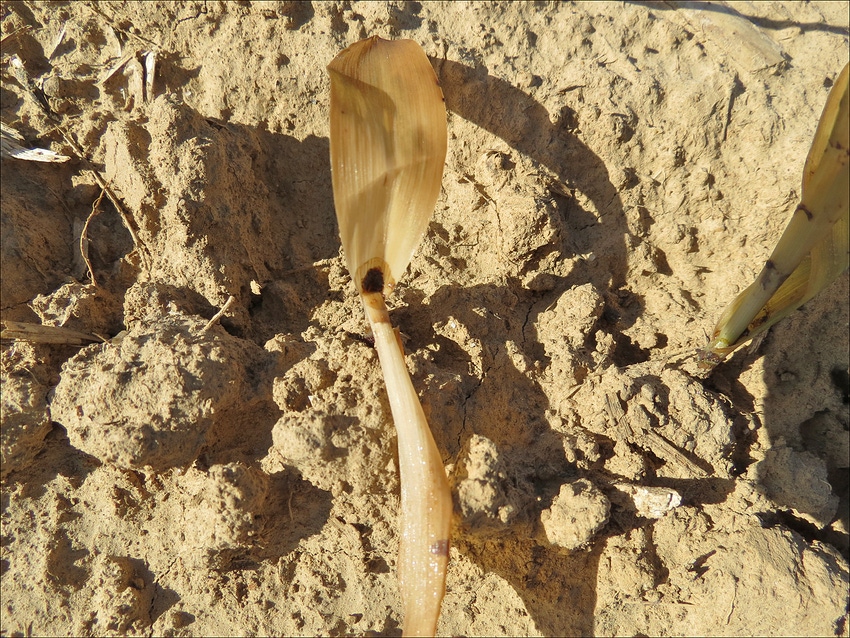April 23, 2013

With the 2012 growing season a distant memory, many are remembering how unpredictable and challenging early springs in Louisiana can be. Unlike many states around the Mid-South, Louisiana was fortunate enough to get a large portion of its corn crop planted within the recommended time frame. However this year’s corn crop has experienced its share of stressful conditions since planting, many of which may have had a significant effect on yield.
Potentially, the biggest challenges during the early part of the 2013 growing season have been the cold temperatures, which have slowed germination and growth of young corn plants. In addition to overall cooler temperatures, near or below freezing temperatures experienced in the later part of March caused anywhere from very sporadic to widespread damage, especially in northern Louisiana.
Much of the effect of the late March freeze was typically cosmetic or corn exhibited only slight die-back of the exposed leaves because they were between germination and V2. Corn plants experienced similar, but less severe conditions due to temperatures in the mid- to high-30s over the evenings of April 19 and April 20. Furthermore, a lot of corn is now at a much more vulnerable stage nearing V5-6, where the growth point is no longer protected underneath the soil surface.
While high yield loss or overall corn stand loss not likely with these conditions, corn needs to be strictly monitored by checking to ensure the growth point is still active and alive. To check, take the corn in question and split the corn lengthwise down the stem and identify the growth point. A healthy growth point will be firm and white with a yellow tint, while an injured or dead growth point will be completely brown or appear to have a brown tint.
In addition to the direct damage temperatures are causing, cooler temperatures have intensified many other stressful conditions such as bird damage, nutrient deficiencies, etc. Many of these are due to slower root and aboveground growth compared to other years. Once favorable conditions return, normal growth recommences, but overall effects on growth and yield are not known.
For the second year in a row, several areas throughout Louisiana are reporting yellow striped corn on newly emerged leaves at very early leaf stages. While these symptoms are very distinct, they can potentially be attributed to different problems.
Zinc deficiency
The first and probably highest probability is zinc deficiency. While zinc uptake is less than for the macronutrients N, P and K, it does not make it any less important. Zinc deficiencies are actually somewhat common to Louisiana. However these deficiencies have normally been located in the Red River alluvial soils. The increasing incidence of zinc deficiencies in the upland loess of the Macon Ridge and Mississippi alluvial soils are a growing concern.
The other nutrient deficiency that could cause symptoms is sulfur. While sulfur deficiencies do not typically present with striped sclerosis, many agronomists from around the United States have reported sulfur deficiencies as interveinal chlorosis (striped sclerosis).
While this early-season, striped chlorosis can be easily attributed to a soil nutrient deficiency, cool and wet conditions could potentially be causing the symptoms. These cold, saturated soils can inhibit early root development, as mentioned earlier, and limit the ability of corn plants to access available nutrients. Therefore, plants are experiencing nutrient stress when adequate supplies are available – the roots are just not able to access them.
To determine the cause of this early-season deficiency symptom, both plant and soil samples need to be collected. While tissue samples might tell you what’s causing the symptoms, correcting for the symptoms depends on whether the crop is not able to access the nutrient or if adequate nutrients are not present in the soil. When collecting a sample to determine nutrient deficiencies, samples need to be collected from areas of the field that appear to be growing well without symptoms and from problem areas of the field that are exhibiting the deficiency.
Nitrogen management decisions are critical in corn production. Additionally nitrogen has a high degree of losses throughout the growing season. Two of the most important loss mechanisms for Louisiana are denitrification and leaching. Both are associated with heavy precipitation events and periods of high soil moisture, similar to what we have experienced in recent weeks.
While these conditions themselves do indicate high nitrogen losses, it is something that needs to be monitored closely in the coming weeks. With increasing temperatures and drier conditions hopefully in the future, growers, agents and consultants need to keep an eye out for signs of nitrogen deficiencies that could indicate a high amount of early-season nitrogen losses.
In corn, chlorosis will begin at the tips of the older leaves and will continue to progress along the mid-vein. In severe cases, chlorosis will spread to the leaf margins and will begin to turn necrotic. Eventually these leaves will drop prematurely, and if the deficiency continues, will progress further up the plant.
However nitrogen is a nutrient which does respond very well to rescue fertilizer applications through mid-to-late vegetative stages.
You May Also Like




